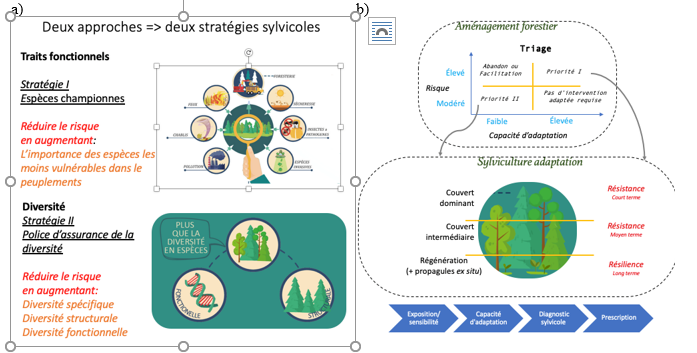Forêt s’adapter : Development of silviculture that fosters the adaptation of the upper St. Lawrence River Valley forests to global changes
The project will increase awareness among local forest managers, advisors and owners of current and future global changes and the management of uncertainty in the planning of their forested land.
Project details
Principal(s) investigator(s)

Context
In Canada, private forests are located in rural areas and play a fundamental role in the functioning of the agro-forest landscape as it provides important goods and services to both the owners of woodlands and their surrounding communities. In the future, these forests, often limited in size and fragmented, will face uncertain, if not hostile, conditions due to global changes. The latter may include climate change, air pollutants or invasive species.
These biophysical and biological forcings will cause changes in the composition, structure and functions played by these ecosystems, threatening the ecological integrity and ecosystem services they provide. The owners who manage forests for various purposes are vulnerable to these threats and are seeking solutions to render their woodlands less vulnerable.
Objective(s)
Develop a silviculture promoting the adaptation of forests of the Upper Saint Lawrence River Valley to global change.
Methodology
-
Evaluation of the current and future exposure and sensitivity of the Upper Saint Lawrence River Valley forests to global changes (drought, invasive species, insect pests and pollution).
-
Characterization of the adaptive capacity of these forests to various threats related to overall global changes and evaluated in the previous step.
-
Implementation of silviculture adaptation measures using the tools previously developed, namely with the view to developing a portfolio of silvicultural options using a robust multi-path approach
Results
Findings in view of the adaptation of forests in the upper St. Lawrence River Valley
-
Although some sites are more at risk than others, in general, the threats from global changes that were investigated in the project have so far had little impact on the functions and integrity of the forests of the upper St. Lawrence River Valley.
-
The forests of the upper St. Lawrence River Valley exhibit great diversity in terms of species as well as the functional traits represented by them, with regard to trees as well as undergrowth plants (shrubs and herbaceous plants), giving them high adaptability.
-
The silviculture normally practised in the forests of the upper St. Lawrence River Valley, involving partial cutting operations, makes it easy to integrate the concepts of strengthening adaptive capacity through recognition at a fine scale, namely that of trees, of exposure factors (such as microtopographic position), sensitivity (species, stage, social status, vigour) and adaptive capacity (life-history traits, functional traits in response to the stresses of global changes, phenotypic plasticity).
Recommendations for the adaptation of the upper St. Lawrence River Valley forests
-
Avoid certain practices likely to reduce forest diversity (such as the “purification” of sugar bushes for maple syrup production).
-
Maintain remnant trees (and shrub hedges) along the edges of fields, especially around forest stands that can serve as biodiversity connectors.
-
Favour the retention of trees on hills rather than in hollows when marking trees to be taken during partial cutting operations.
-
Apply the “adaptation triage” approach at the landscape scale to identify at-risk stands representing the best options for strengthening adaptive capacity.
-
Avoid excessive use of nitrogen fertilizers near forests.
-
Identify the risks of invasions and monitor forests already showing invasion by exotic species (particularly buckthorn (Rhamnus cathartica and Frangula alnus).
-
In partnership with forestry advisors, the Agence de mise en valeur des forêts privées de la Montérégie, the Fédération des producteurs acéricoles du Québec and the Fédération des producteurs forestiers du Québec, develop a region-wide adaptation strategy as part of the protection and development plan for private forests.
-
Include methods for assessing exposure to threats from global changes and the sensitivity of forests in these strategies, and help professionals integrate the notions of strengthening adaptive capacity into their silvicultural diagnoses when preparing a silvicultural prescription.

Figure 1. (a) Adaptive capacity can be assessed on the basis of species-specific adaptations, as seen in the specific functional traits of resistance and resilience to disturbances and stresses (the so-called “champion species” adaptation strategy) and on the basis of species, functional and structural diversity (the so-called “diversity insurance policy” adaption strategy). (b) The triage approach to identify the adaptation priorities for a managed piece of land and the discrimination of gains in adaptation capacity according to the layer of the stand.
Benefits for adaptation
The project will increase awareness among local forest managers, advisors and owners of current and future global changes and the management of uncertainty in the planning of their forested land.
The procedures and tools developed as part of the project will help them make informed decisions to develop their forests based on this context.
In particular, the development of silvicultural operations aimed at strengthening the adaptive capacity of forests will make it possible to broaden the range of management activities offered by forestry experts in the area.
The project's methodology and deliverables are transferable to other regions facing similar situations in Quebec or in Nova Scotia, New Brunswick and Ontario.
Funding



Other participants
-
Université du Québec à Montréal
-
Université Sherbrooke
-
Université de Montréal